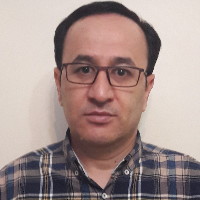Effects of biological soil crusts on surface runoff quality
Arid and semi-arid areas often have sparse and scattered vegetation cover. In many arid regions of the world, open spaces between plants are occupied by particular living organisms called biological soil crusts (BSCs) or biocrusts. BSCs are the dense population of living organisms such as cyanobacteria, algae, fungi, lichens, and mosses in different proportions that live on the soil surface or within the upper few millimeters of soil. The aim of the present study was to investigate the effect of biological soil crusts on surface runoff quality in hillslopes around Ajigol Wetland in the Golestan Province of Iran.
The study area is located in the northern part of Golestan Province. Elevation in the study area ranges from 7 to 32 meters above sea level. The topography of the area is gentle and the land surface is composed of loess deposits. According to the climatic conditions, the research area is classified as arid and semi-arid regions. Due to a lack of rainfall, high evaporation, and uneven distribution of rainfall throughout the year, as well as high soil salinity, it has low-growing and weak rangeland plants. The vegetation in the area is composed mainly of annual grass species scattered heterogeneously. They often appear after rain events and have a short growth period finishing the life cycle in one season. In this research a field rainfall simulator was used. First, field visits were conducted to select places for positioning rainfall-runoff simulation plots in different types of biocrusts. To eliminate the effect of slope on runoff processes, locations were selected whose slope was around the dominant slope of the region (around 20 %). Rainfall-runoff simulations were carried out using a rainfall simulator over 1 x 2-m plots with and without biological soil crusts. The intensity of the simulated rainfalls was about 80 mm h-1 and the duration of each simulation was 30 min. The plots were positioned over five different types of surface cover including 1) dominant moss cover, 2) dominant lichen cover, 3) mixed (moss + lichen) cover, 4) dominant shrub (Artemisia spp.) cover, and 5) Bare land. Sampling and measurement of some runoff quality variables (sediment, electrical conductivity (EC), acidity (pH), color, and Total Dissolved Solids (TDS)) were conducted at 15-minute intervals during the simulation, plus one more sample from a mixture of runoff of the whole simulation. For some other water quality variables (organic carbon, nitrate, phosphorus, and potassium) measurements were made only at the end of the simulation from the total runoff mixture. The data were analyzed using graphical methods (plots) and statistical tests: analysis of variance (ANOVA), Kruskal-Wallis, and Tukey’s test.
The results showed that sediment concentrations were significantly (P ˂ 0.05) lower for biocrust-covered plots compared to the plots without biocrusts. Extreme differences were observed for the bare soil. EC, pH, color and TDS values also had significant differences between different covers. For organic carbon, phosphorus, nitrate, and potassium, no significant differences (P ˂ 0.05) between covers were detected by statistical tests though some notable differences were discernible on plots. The origin of runoff EC is mostly inorganic substances and it is caused by natural and human-induced pollution. There was a significant difference (P ˂ 0.05) between shrub-covered plots and plots with a combination of moss and lichen. EC for the shrub cover (Artemisia spp.) was found to be significantly higher than the mixed moss and lichen cover. The reason can be attributed to the increase in permeability and soil moisture in BSC dominated areas. Increased infiltration of water by biocrusts causes salts and ions to move deeper into the soil and this reduces the salinity of upper soil layer and surface runoff. With regard to runoff color, a significant difference (P˂ 0.05) was observed between bare soil and the other cover types. By producing polysaccharides and viscous materials, BSCs preserve and stabilize the soil surface materials and reduces the transport of metal ions (such as iron and manganese), decayed plant materials, organic matter, and animal waste as the main factors for the coloration of runoff. In contrast, more detachment and transfer of materials from bare soil have caused the runoff to become thicker and darker. The amount of sediment concentration from bare land was higher than shrubland and biocrust covers. For example, the average sediment concentration in the runoff from plots of bare land was about three times that of Artemisia plots. Another notable point was the large difference in sediment concentration between bare soil plots themselves. The reason for this was attributed to the presence of remaining roots of annual plants in the bare soil plots, which influence runoff and soil loss.
Overall, the results indicate the major effect of BSCs on runoff quality. So, taking proper measures to protect them and prevent their destruction is of great importance for soil and water conservation as well as water quality preservation in downstream wetlands. Therefore, it is necessary for government agencies to pay more attention to BSC-covered hillslopes around the Ajigol Wetland so no more damages are imposed on these fragile unique resources. As no comprehensive map of BSC covers the study area is present, it is recommended that such a map be prepared using satellite and drone imagery. Then, by combining the results of this study with the information obtained from mapping and generalizing it to the entire region, it is possible to make an overall estimate of the effect of BSCs on the water quality of downstream wetlands which is necessary for better-informed planning and decision-making. Exclosure and cover protection measures to prevent physical damages caused by human activities need to be implemented for the BSC-covered areas so they can continue their function as living mulch and protect soil from water and wind erosion.
- حق عضویت دریافتی صرف حمایت از نشریات عضو و نگهداری، تکمیل و توسعه مگیران میشود.
- پرداخت حق اشتراک و دانلود مقالات اجازه بازنشر آن در سایر رسانههای چاپی و دیجیتال را به کاربر نمیدهد.


